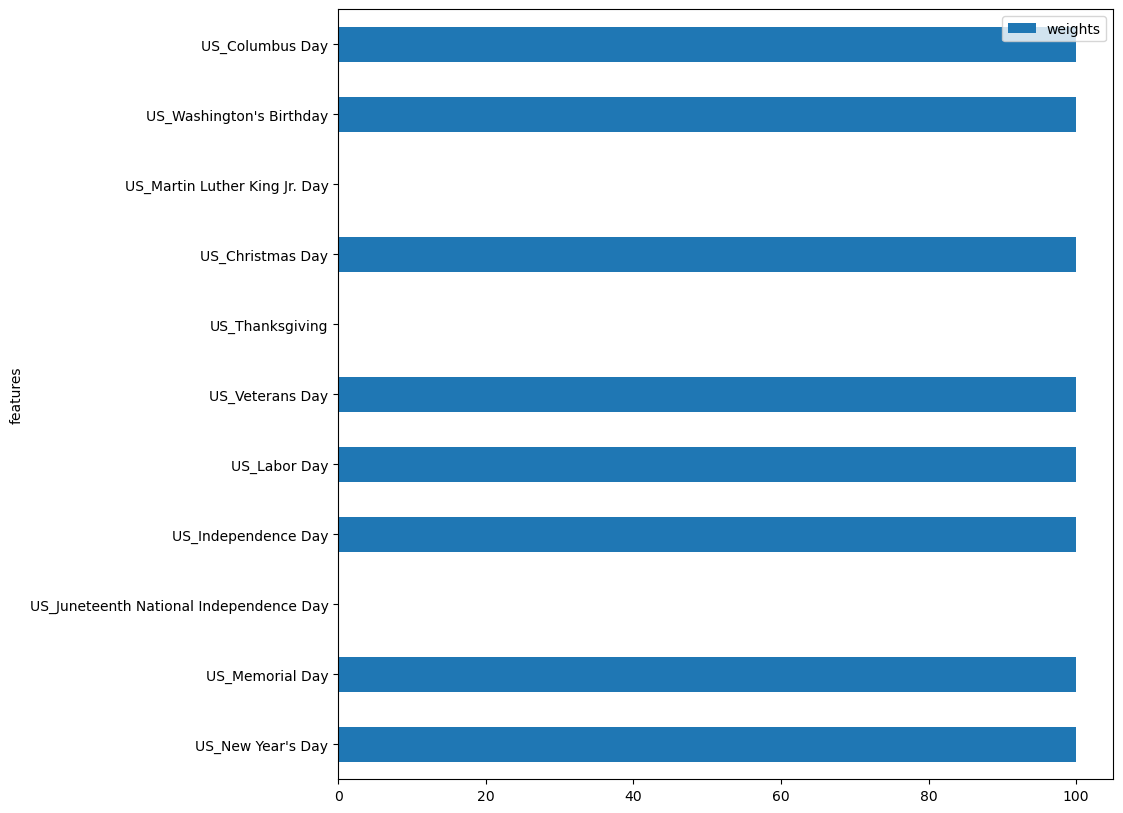date_features function.
1. Import packages
First, we import the required packages and initialize the Nixtla client.👍 Use an Azure AI endpoint To use an Azure AI endpoint, remember to set also thebase_urlargument:nixtla_client = NixtlaClient(base_url="you azure ai endpoint", api_key="your api_key")
2. Load data
We will use a Google trends dataset on chocolate, with monthly data.| month | chocolate | |
|---|---|---|
| 0 | 2004-01-31 | 35 |
| 1 | 2004-02-29 | 45 |
| 2 | 2004-03-31 | 28 |
| 3 | 2004-04-30 | 30 |
| 4 | 2004-05-31 | 29 |
3. Forecasting with holidays and special dates
Given the predominance usage of calendar variables, we included an automatic creation of common calendar variables to the forecast method as a pre-processing step. Let’s create a future dataframe that contains the upcoming holidays in the United States.| month | US_New Year’s Day | US_Memorial Day | US_Juneteenth National Independence Day | US_Independence Day | US_Labor Day | US_Veterans Day | US_Thanksgiving | US_Christmas Day | US_Martin Luther King Jr. Day | US_Washington’s Birthday | US_Columbus Day | |
|---|---|---|---|---|---|---|---|---|---|---|---|---|
| 0 | 2024-05-31 | 0 | 0 | 0 | 0 | 0 | 0 | 0 | 0 | 0 | 0 | 0 |
| 1 | 2024-06-30 | 0 | 0 | 1 | 0 | 0 | 0 | 0 | 0 | 0 | 0 | 0 |
| 2 | 2024-07-31 | 0 | 0 | 0 | 1 | 0 | 0 | 0 | 0 | 0 | 0 | 0 |
| 3 | 2024-08-31 | 0 | 0 | 0 | 0 | 0 | 0 | 0 | 0 | 0 | 0 | 0 |
| 4 | 2024-09-30 | 0 | 0 | 0 | 0 | 1 | 0 | 0 | 0 | 0 | 0 | 0 |
| month | chocolate | US_New Year’s Day | US_New Year’s Day (observed) | US_Memorial Day | US_Independence Day | US_Independence Day (observed) | US_Labor Day | US_Veterans Day | US_Thanksgiving | US_Christmas Day | US_Christmas Day (observed) | US_Martin Luther King Jr. Day | US_Washington’s Birthday | US_Columbus Day | US_Veterans Day (observed) | US_Juneteenth National Independence Day | US_Juneteenth National Independence Day (observed) | |
|---|---|---|---|---|---|---|---|---|---|---|---|---|---|---|---|---|---|---|
| 239 | 2023-12-31 | 90 | 0 | 0 | 0 | 0 | 0 | 0 | 0 | 0 | 1 | 0 | 0 | 0 | 0 | 0 | 0 | 0 |
| 240 | 2024-01-31 | 64 | 1 | 0 | 0 | 0 | 0 | 0 | 0 | 0 | 0 | 0 | 1 | 0 | 0 | 0 | 0 | 0 |
| 241 | 2024-02-29 | 66 | 0 | 0 | 0 | 0 | 0 | 0 | 0 | 0 | 0 | 0 | 0 | 1 | 0 | 0 | 0 | 0 |
| 242 | 2024-03-31 | 59 | 0 | 0 | 0 | 0 | 0 | 0 | 0 | 0 | 0 | 0 | 0 | 0 | 0 | 0 | 0 | 0 |
| 243 | 2024-04-30 | 51 | 0 | 0 | 0 | 0 | 0 | 0 | 0 | 0 | 0 | 0 | 0 | 0 | 0 | 0 | 0 | 0 |
📘 Available models in Azure AI If you are using an Azure AI endpoint, please be sure to setmodel="azureai":nixtla_client.forecast(..., model="azureai")For the public API, we support two models:timegpt-1andtimegpt-1-long-horizon. By default,timegpt-1is used. Please see this tutorial on how and when to usetimegpt-1-long-horizon.
 We can then plot the weights of each holiday to see which are more
important in forecasing the interest in chocolate.
We can then plot the weights of each holiday to see which are more
important in forecasing the interest in chocolate.
 Here’s a breakdown of how the
Here’s a breakdown of how the date_features parameter works:
date_features(bool or list of str or callable): This parameter specifies which date attributes to consider.- If set to
True, the model will automatically add the most common date features related to the frequency of the given dataframe (df). For a daily frequency, this could include features like day of the week, month, and year. - If provided a list of strings, it will consider those specific
date attributes. For example,
date_features=['weekday', 'month']will only add the day of the week and month as features. - If provided a callable, it should be a function that takes dates as input and returns the desired feature. This gives flexibility in computing custom date features.
- If set to
date_features_to_one_hot(bool or list of str): After determining the date features, one might want to one-hot encode them, especially if they are categorical in nature (like weekdays). One-hot encoding transforms these categorical features into a binary matrix, making them more suitable for many machine learning algorithms.- If
date_features=True, then by default, all computed date features will be one-hot encoded. - If provided a list of strings, only those specific date features will be one-hot encoded.
- If
date_features and date_features_to_one_hot
parameters, one can efficiently incorporate the temporal effects of date
attributes into their forecasting model, potentially enhancing its
accuracy and interpretability.
